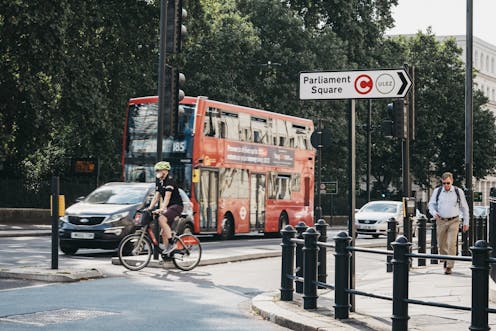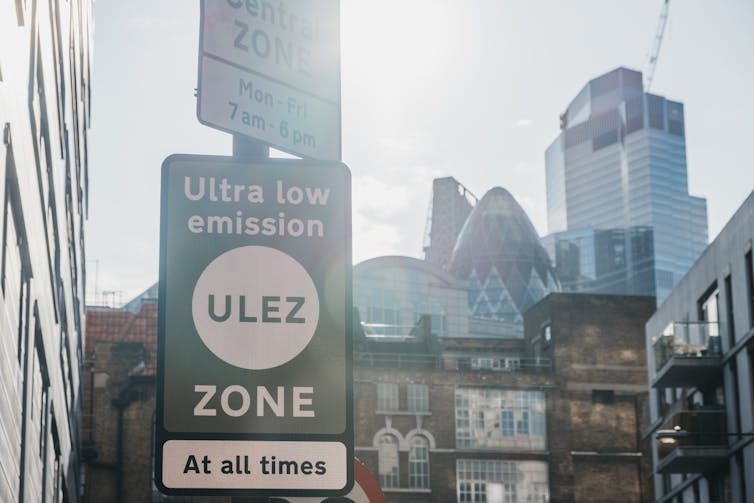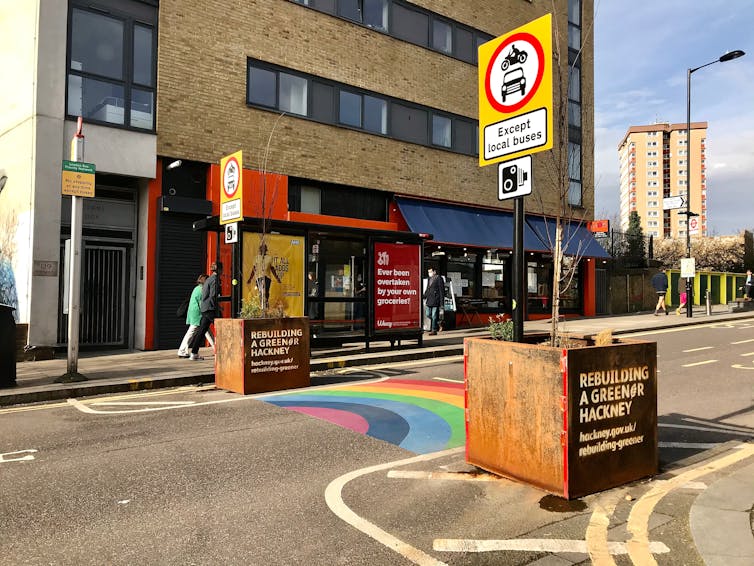
On November 25 2022 Sadiq Khan, Mayor of London, announced plans to expand the Ultra Low Emission Zone (ULEZ) to cover the whole of Greater London. According to Khan, this will “ensure 5 million more Londoners can breathe cleaner air”.
While there have been significant improvements in London’s air quality in recent years, 99% of the city’s residents still live in areas that exceed World Health Organisation limits for air pollution, specifically particulate matter (PM) 2.5, which is emitted by vehicles, among other sources.
In December 2020, an inquest into the death of nine-year old Ella Adoo-Kissi-Debrah concluded that the air she had been breathing was a contributing factor. This marked the first time in the UK that air pollution had been cited a cause of death.
Few politicians doubt the extent of London’s air pollution problem. There is, however, widespread disagreement on what to do about it. Khan’s claim that the ULEZ expansion will improve the lives of millions is, no doubt, a bold one, but one that is generally supported by evidence from London and similar schemes elsewhere. However, to achieve the radical improvements in air quality that are needed, this cannot be the only intervention. Further, important questions on the fairness of the ULEZ expansion remain, particularly around the impacts on lower income parts of outer London where public transport is less accessible.

Alena Veasey | Shutterstock
How the ULEZ came about
In February 2008, the UK capital launched the first emissions control scheme: the Low Emission Zone (LEZ). This initially began as a charge to drive heavy-goods vehicles (HGVs) over 12 tonnes into the city centre and was extended, five months later, to include HGVs over 3.5 tonnes, buses and coaches. Subsequent revisions have resulted in it applying, since 2021, to all large commercial vehicles that do not meet European emissions standards, specifically the Euro IV standards.
While some research has shown that initial projections of LEZ-related emissions decreases were too optimistic, there is evidence that air quality has improved. Precisely how much so varies, depending on the study, from the substantial to the minute.
In April 2019, the Mayor of London upped the ante in introducing the ULEZ – the world’s most stringent low emission zone – to cover Central London. Unlike the LEZ, the ULEZ targets all motorised vehicles that do not comply with European emissions standards. In October 2021, the ULEZ was expanded as far as the London’s North and South Circular roads, becoming 18 times its original size.
The impact the ULEZ has had
Initial findings from the Greater London Authority (GLA), attributed a significant and positive effect on air quality to the ULEZ. Between July and September 2019, the GLA noted a 29% reduction in nitrogen dioxide (NO₂) concentrations, and between February 2017 and February 2020, a 44% reduction in NO₂ concentrations at Central London roadside locations. This matches findings from similar schemes in German cities and in Madrid.
Recent research using more advanced statistical methods have found smaller improvements in air quality. Though the improvements were still significant, these findings have led researchers of one such study at Imperial College London to conclude that “the ULEZ on its own is not an effective strategy in the sense that the marginal causal effects were small”.
While the effects of ULEZ on air quality are positive, they are limited by the large proportion of vehicles that already comply and pollution levels that are linked to other activities and vehicles. Radically reducing air pollution in London requires not just more ULEZ but a diverse set of policies implemented by local, regional and national governments.

Will Durrant | Shutterstock
One such policy is low traffic neighbourhoods (LTNs), where planters and cameras block residential through-roads to motor vehicles. Although controversial, there is mounting evidence that, in London at least, LTNs have been successful in lowering NO₂ levels, reducing car ownership and encouraging active travel, reducing road traffic injuries and lowering street crime.
Is expanding the ULEZ fair?
The expansion of the ULEZ should be judged on more than just whether it improves overall air quality. We should also ask: who benefits most? Is there displacement of pollution? And does the ULEZ have public support?
Proponents claim that such transport interventions are fair as they benefit residents in poorer areas who are already more exposed to poor air quality. Opponents, such as the London Borough of Bexley, claim that they lower transport accessibility, unfairly impact low-income residents and displace pollution from one area to another.
Projections related to the expansion of the ULEZ are not publicly available. However, the Central London ULEZ is predicted to substantially reduce exposure to harmful NO₂ concentrations in London’s most deprived areas by 2030.
In contrast, a recent study suggested that it was unclear that residents in poorer London areas were actually more exposed to air pollution. Perhaps more concerning, as ULEZ expands into further flung areas of Outer London, the same study found that lower income areas had a higher proportion of non-compliant cars as well as worse public transport. The lack of public transport accessibility in poorer parts of outer London is a key objection of some outer London borough councils.
While questions should be asked about these effects on accessibility and social inclusion, there is no evidence of displaced pollution on to nearby areas from the original LEZ nor its 2021 expansion, nor indeed other European low-emission zones. Rather, nearby areas and boundary roads appear to also benefit from improved air quality.
Overall, evidence from the LEZ and subsequent ULEZ implementation so far is largely positive. It has improved air quality for millions of Londoners and there is little to suggest its expansion will do otherwise.
However, on its own, there is a ceiling to how much effect it can have. To radically improve air quality, it must be implemented alongside other national, regional and local measures, from LTNs to increased pedestrianisation. Most importantly, if its expansion is to be considered fair, public transport in outer London must be improved too.
![]()
Dr Jamie Furlong receives funding from TfL for a related project analysing behaviour change and Low Traffic Neighbourhoods. He also receives funding, as part of a team at Westminster University, from the National Institute for Health Research for a project examining the effects of Low Traffic Neighbourhoods in London.
Source: TheConversation


